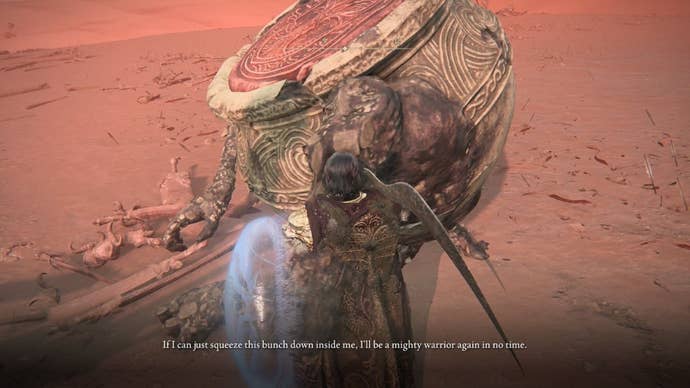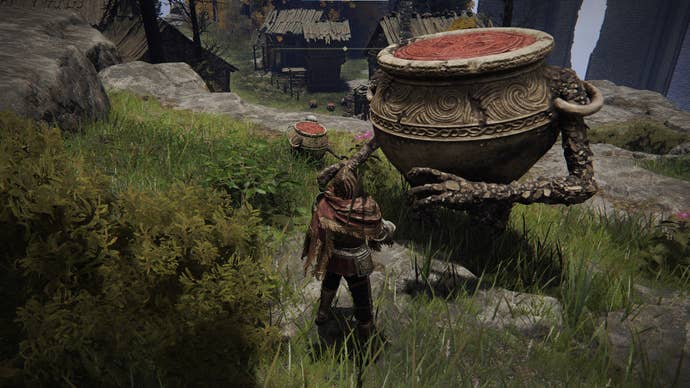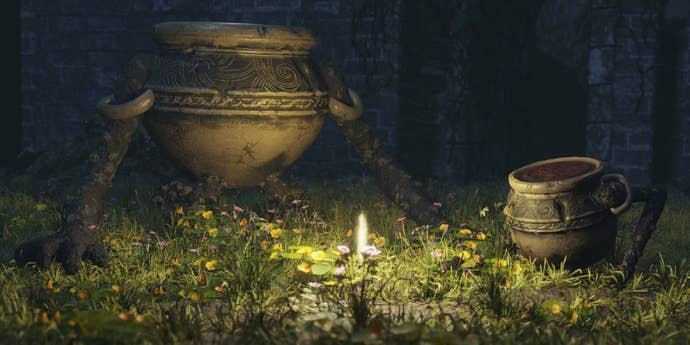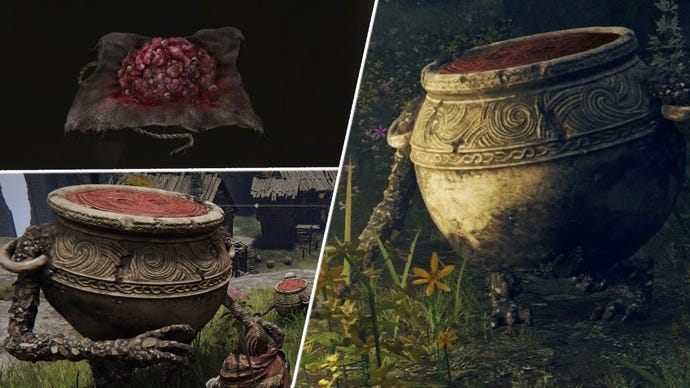Elden Ring's Living Jars are the nightmare fuel that just keeps on giving
How would you like to spend eternity crammed into a sentient jar? Because, in the Lands Between, that's probably quite a likely fate.
I can’t stop thinking about Elden Ring’s Living Jars – and not in a wholesome way. Yes, I was swept along in the initial wave of pot-worship, aaawing at their little arms and legs and wanting to pinch their clay cheeks like some over-familiar, boundary-ignorant grandma.
But now, I see them for the ceramic horrors they are, Milkshake Ducks with rotting corpses instead of racism. And while I’ve tried to put them out of my mind, temporarily leaving The Lands Between for the more wholesome, youngling-juggling shenanigans of LEGO Star Wars: The Skywalker Saga, the nightmare fuel just keeps on flowing, even when I’m away.
It was the battle with Starscourge Radahn and his tiny, tiny, horse that clued me into the Jars’ true nature. The needle scratch moment came when, roaming the battlefield after Radahn had fallen, I saw Alexander, Warrior Jar, pawing at the ground. I wandered over to thank him for his assistance, having summoned him more times than was strictly healthy. Then, after a couple of mundane lines of conversation, he dropped this bombshell:
“As luck would have it, there's a veritable mountain of warriors' bodies right here. If I can just squeeze this bunch down inside me, I'll be a mighty warrior again in no time.”
That’s great Alexander, good luck with–– wait, what?

There are, I admit, clues I missed out on – maybe I should have wondered why Alexander’s more aggressive brethren would, periodically, drop a “raw meat dumpling” when dispatched. I definitely shouldn’t have eaten it, but I figured it was just random loot, subject to the same warped RPG logic that, in other games, has rats dropping gold coins.
But, no, what I’d shoved down my protagonist’s face-hole was a glob of human flesh. And while From Software have stopped just short of making them slosh when they move, the horrifying truth of Elden Ring’s Living Jars is that these “adorable” animated pots are crammed with the ruined and decaying remains of fallen warriors, bodies and body-parts alike.

This revelation alone is stomach-churningly awful, but it raises so, so many questions – only a few of which are conclusively addressed. Take the bloodstains, for example, which show you how another player met their demise. There’s no corpse because what you’re seeing took place in some parallel universe, right? But what if the real reason is that, the moment someone expires, the Living Jars descend on them, greedily grasping at their lifeless flesh, shoving handful after wet handful beneath their lids.
Picture this – you’re laying bleeding but alive on some battlefield, the skirmish itself long since ended. Fighting the pain, you drag yourself along the ground, seeking something, anything to prolong your waning life. You marched past a merchant’s shack a mile back, if you can make it that far, maybe you can.. and that’s when the Jars start to arrive.
There are just a couple at first, picking over the remains of a fallen comrade. You watch in horror as they crack open his skull, holding the brain aloft like some treasured relic. You turn away before you see what they do with it, but the sound is sickening enough that, fearing the fate that awaits you, you struggle to rise to your knees.

That’s when you spy the squat, rotund figures standing a few metres, their inscrutable faces, or whatever blank stretch of jar functions as a face, trained on you and you know you’re not leaving here alive. Maybe they wait for you to breathe your last before they sink their clay claws into you. Maybe they don’t.
And that, believe it or not, isn’t the worst of it. The Living Jars think that by harvesting the flesh of the dead they gain their knowledge and those fighters live on through each Jar. Yes, you have to spank Alexander out of a hole, but a visit to the hidden village of Jarburg, home of the Living Jars, (which also saw me revise my smash-on-sight policy), confirms it’s not an isolated belief.

“Many great warriors reside within me, ever dreaming of becoming a great champion... one day, we'll be a single great champion. The greatest of them all!” he explains. The best case scenario is that he’s wrong and, unsettling as it is that the jars roam around crammed with carrion, any perceived improvement in combat skill is just a placebo effect.
But what if they’re right, and scooping someone into their insides does grant them access to their experiences and knowledge? The Elden Ring Wiki’s Living Jar entry, which I’m pretty sure is written by a Living Jar, tries to sell it as a touching form of immortality, as does, to a lesser extent, the game itself.
Am I buying that? Not in a million years. Elden Ring is a little fuzzy on whether there’s an afterlife or, indeed, whether The Lands Between are, themselves, some kind of afterlife. Imagine expiring only to find that, instead of wandering the Elysian Fields, you’re part of some soupy semi-sentient sludge or, if the Jar in question is vast enough, your broken corpse is crammed in alongside a dozen others.

You might be able to communicate, if you’re lucky, with your fellow doomed souls but, not unlike Jordan Peele’s brilliant Get Out, you’d have little influence over the vessel that was now your prison. Even the death of your host wouldn’t guarantee you release; as one Jarburg quest reveals, Jars can pass their insides around, meaning that you could be “around” for hundreds, maybe thousands of years.
Admittedly, I’m a huge horror aficionado, which may well be why my mind has gone down this particular rabbit hole. Elden Ring’s certainly not short on horror; one monster is just a group of people grafted together and your protagonist can “die” as thorny vines burst out of their torso, lifting their skewered corpse off the ground. But Elden Ring’s Living Jars are such brilliant, nightmarish creations that – like Doctor Who’s Weeping Angels – they almost eclipse the medium that spawned them.
I don’t know whether the Jars sprang from the mind of Hidetaka Miyazaki or collaborator George R.R. Martin, though based on previous From Software games, I suspect the former. What I can tell you is that the Living Jars have moved into my head, disturbing hand-me-downs included, and they won’t be leaving any time soon.



.jpg?width=291&height=164&fit=crop&quality=80&format=jpg&auto=webp)





